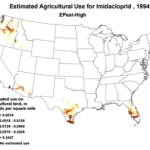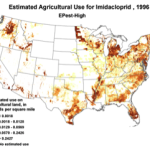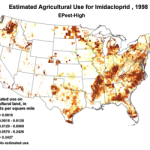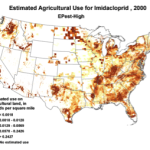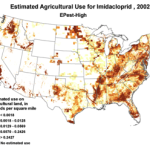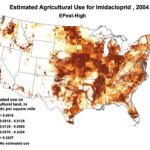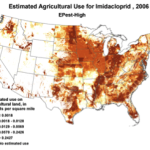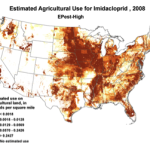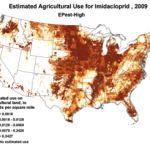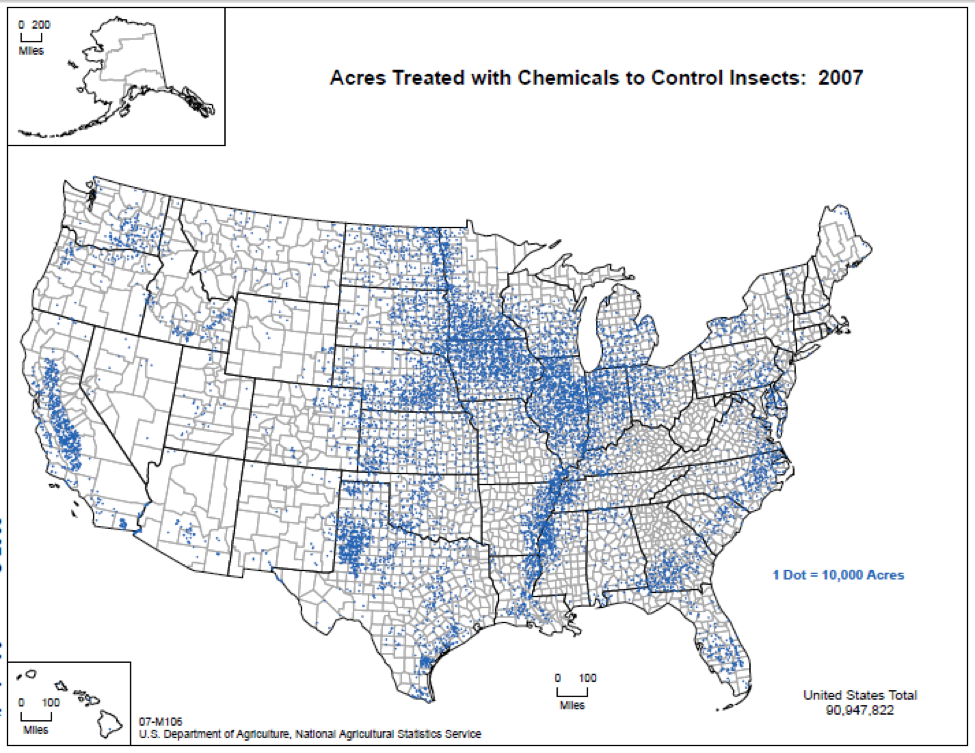Sick Bees – Part 18F6: Colony Collapse Revisited – The Slaughter of the Innocents
The Slaughter of the Innocents
Why the Current Hoopla on Pesticides?
The Slaughter of the Innocents
Hitting the Colony Where it Really Hurts
Progress in Reducing Pesticide Use
Sick Bees Part 18f6: Colony Collapse Revisited
the Slaughter of the Innocents
First published in ABJ September 2013
Randy Oliver
ScientificBeekeeping.com
The Slaughter of the Innocents
I’ve just learned something that helps me to understand what drives me to write these articles. Scientists have recently discovered that some people’s brains are wired for wanting to share useful information with others [1]. I’ve always been this way—I love learning about things and then sharing what I’ve learned with others. Learning about pesticide issues with bees has certainly been an educational experience for me, taking me down roads that I’d never imagined, and forcing me to rethink many of my previous assumptions. So please allow me to continue into my investigation of pesticides and their relationship to colony mortality.
Why the Current Hoopla on Pesticides?
The pesticide situation for bees has clearly improved since the “bad old days” of the 1960’s and ‘70’s [2], and doesn’t seem to be much different than when the Ericksons wrote about the subject in ABJ back in the 1980’s (a “must read” for anyone interested in this subject; copies at my website [3]). Yet today a media circus has convinced the public that certain pesticides are suddenly driving bees to extinction, and our industry has come together to bring a test case against the EPA to see whether we can finally get more bee-friendly restrictions in the labeling of new pesticide registrations. So why the current renewed interest in pesticide issues?
The simple answer is that beekeepers are hurting! Winter colony losses are averaging an excessive 30 percent, which makes beekeeping less profitable. It is simply more difficult and expensive to keep bees these days. Everyone is looking for something simple to blame, and pesticides have a long history of causing problems for bees. The mass media love to spin public fears of into doomsday stories, and they know that this story has all the necessary elements to sell to a largely urbanized population far removed from the realities of agriculture, nature, and beekeeping, with an innate distrust of any sort of chemicals or the companies that make them, and a renewed environmental consciousness (a good thing).
Then add the circumstantial widespread adoption of a new class of insecticides (Fig. 1), with scary-sounding words like “CCD,” “neonicotinoid,” “neurotoxin,” “lethal dose,” and “systemic,” and activists who have adopted our beloved honey bee their cause célèbre. Anyone can go to the internet to enjoy the current theatre of the absurd in which bloggers, advocates, and petitioners spin legitimate science, imaginative speculation, and outright misinformation into a frenzied free for all. Yet the question still remains, to what extent are pesticides truly to blame?
 Use of the neonicotinoid insecticide imidacloprid over time. USGS data |
||
Figure 1. Use of the older classes of insecticides is being supplanted by newer (and ostensibly more eco-friendly) compounds such as the neonicotinoids. The widespread adoption of one of them has garnered the most attention—there were 284 published scientific studies with the word “imidacloprid” in the title in 2012 through the first half of 2013 alone! Yet we are still trying to determine whether any adverse sublethal effects of these insecticides are related to the generally increased rate of winter colony losses since the winter of 2004/2005. Source of maps [4].
Yet for all this interest in pesticides and bees, no one has yet produced a smoking gun that conclusively shows that pesticides are actually the major problem. I’ve previously listed studies from every continent that failed to make any clear link between pesticides and increased colony mortality [5]. But that doesn’t necessarily mean that they aren’t contributing to colony morbidity—a “weakening” or state of unhealthiness. Beekeepers and toxicologists have long known that pesticide residues can cause slower colony build up, poor brood patterns, decreased honey production, increased queen supersedure or failure, small populations in fall, or poor wintering.
But it’s silly to blame all beekeeping problems on one thing. I’ve no doubt that pesticides are a serious issue for some beekeepers (especially the large operators with thousands of hives in the middle of intense agriculture), but I also have seen that they are also a non issue for the majority of beekeepers elsewhere. What I’m trying to figure out is exactly where pesticides fit into the larger picture of the elevated rate of colony mortality of late. Since most exposure of honey bees to pesticides is in either agricultural or landscape settings, let me start my investigation into this subject from the ecological perspective of agricultural systems.
Ecosystems and Agriculture
Every form of life on Earth is part of a local ecosystem, in which the plants, animals, and microbes exist in some sort of “dynamic equilibrium”—commonly referred to as the “balance of Nature” (which in fact can tip wildly one way or the other). The more mature an ecosystem, the greater the diversity of species, the more complex the “food web,” and the more stable and resilient that balance.
One of the main factors that keeps any single plant species from dominating the landscape are the herbivorous insects that can quickly adjust their populations to exploit such a food resource. In response, through the process of “coadaptation,” the plants fight back against those insects with constantly-evolving chemical warfare. As beekeepers, we should keep in mind how insects (including honey bees) perceive the environment very differently than the way in which we humans do—insects are far more attuned to the chemical attractants, deterrents, and toxic metabolites of plants.
When we humans practice agriculture, we greatly disrupt or destroy the preexisting natural ecosystem and replace it with an artificial system designed to favor certain domesticated plants—“high-yielding” cultivars which generally possess less innate resistance to herbivorous insects.
In traditional agricultural systems, farmers grew locally-adapted (“heirloom”) cultivars of crops that often displayed some degree of resistance to the local insects. In addition, farms used to be small family affairs, and tended to be biologically diverse, containing a wide variety of domesticated and wild plants, grazing livestock, insect-eating fowl, cropland rotated with pasture, and a scattering of woodlots and hedgerows. This diversity helped to maintain a balance of food sources and natural predators which helped to keep any single insect species from taking too large a bite out of the farm’s total production (not to say that there weren’t problems with pests—especially with generic feeders such as locusts). But diversified farms are resilient in that they tend to limit pest populations. This traditional model of farming would be considered to be “sustainable,” since prior to synthetic fertilizers and pesticides, a farm’s viability from one generation to the next depended upon maintaining soil fertility and functional ecosystems.
On the other hand, in today’s “get big or get out” conventional agricultural model (in the U.S., 85% of farm sales are produced by less than 10 percent of farms, which control 44 percent of farm acreage [6), farmers now plant hundreds or thousands of acres to a single cultivar of domesticated plant. Such a system is ecologically unstable, since it essentially offers an unlimited buffet to whichever species of insects are adapted (or adapt) to consume that particular variety of plant. This sort of agricultural hubris then creates a demand for poisons to kill those plant-eating insects.
Our Creation of Pests
Keep in mind that every plant and insect that we now consider to be a “pest” was originally a part of some natural ecosystem. It is only if such an insect has the audacity to feed on our favored plant that we deem it a “pest.” But remember that such a value judgment is a human construct—that herbivorous insect is innocent in intent and certainly feels no malice towards us! Take the case of the Western Corn Rootworm (WCR), a close relative of the familiar 12-Spotted Cucumber Beetle (also called the Southern Corn Rootworm). The beetle, in its original ecosystem (which did not include corn until Native American farmers brought it north from Mexico) lived unnoticed on native gourds and prairie grasses [7]. But being an opportunistic species, it adapted to feeding on cultivated corn when that crop began being grown in vast monocultures.
In 1909 the WCR was first noticed to be damaging corn in Colorado, but wasn’t a problem in the Midwestern Corn Belt until the 1940’s [8]. Since then it has become one of the most economically-important pests of corn, accounting for about a billion dollars worth of lost revenue a year. It’s important to remember that for a hundred years, farmers minimized WCR damage by managing their farm ecosystem to disfavor the pest. This was done by the simple practice of rotating corn with pasture or legumes—non-host plants for the WCR—and by providing habitat for the parasites and predators of the rootworm—tachinid flies, parasitic wasps, nematodes, lacewings, etc.
But when government price supports made the growing of corn more and more profitable, farmers began to plant “corn on corn.” In doing so, they also grew huge populations of corn rootworms—an insect blindly fulfilling its “role” of bringing an artificial ecosystem back into balance by consuming an overabundant plant species. By working against Nature, farmers create their own “pest” problems.
Every pest also has natural enemies—predators, parasitic wasps, viruses, etc.—that tend to bring excessive populations back into “balance.” Relying upon pesticides rather than cultural practices often messes up this dynamic system, resulting in an even greater resurgence of the population of the pest. As Dr. Patricia Muir explains in her excellent syllabus on pesticides [9]:
One clear example of this effect involves corn in the US. In the 1940’s, little or no insecticide was applied to corn, and losses to insects were 3.5% of production. Since then, insecticide use on corn has increased more than 1000-fold, whereas losses due to insects (especially to the corn rootworm complex) have increased to 12%. This is largely attributed to reductions in crop rotation. When corn is rotated with another crop on which corn pests (such as corn rootworms) cannot survive, the pest population declines during the non-corn years. However, when corn is grown continuously (as it is today on 20 – 40% of US acreages depending on the year and on who you read!), populations of these pests are well fed every year and can increase immensely.
The Slaughter of the Innocents
Rather than reevaluating how to better farm their land in an ecologically-friendly and sustainable model, conventional farmers are pushed by market forces and wooed by pesticide salesmen to “control” these newly-created pests by the extensive application of synthetic insecticides (Fig. 2). In the process of applying these insecticides, vast numbers of “innocent” off-target species (such as honey bees and other “beneficials”) are often slaughtered (see a visual account of this at [10]).
Figure 2. If you add up all the blue dots (each representing 10,000 acres treated with insecticides), it’s easy to see why in some areas it’s hard for beekeepers to find “safe” places for their hives. Source USDA.
Pesticide (Mis)use Today
In today’s factory farming model, one prepares the soil bed, plants the seeds, and controls pests with poisons. It does not have to be this way. Over 50 years ago, entomologists at the University of California laid the foundation for many of the most important concepts in Integrated Pest Management (IPM) to reduce our dependence upon pesticides. Integrated pest management can be defined as the practice of preventing or suppressing damaging populations of insect pests by the application of comprehensive and coordinated control tactics. IPM emphasizes the least possible disruption to agro-ecosystems and encourages natural pest control mechanisms.
IPM has time and again been demonstrated to be both practical and cost effective—greatly reducing the need for pesticide applications by helping to maintain a more natural balance between herbivorous insects (what we call “pests”) and their natural predators.
Despite the long and successful history of IPM [11], it is unfortunate that chemically-based pest control still predominates in U.S. agriculture (the reader may note that IPM also applies to beekeeping, yet is practiced by only by a minority of beekeepers). A recent lament by prominent bumblebee researcher Dr. David Goulson (in his excellent review of neonic issues) describes the situation well [12]:
When I was at University in the 1980s, I read Rachel Carson’s Silent Spring, and was taught about the terrible mistakes made in agriculture in the 1950s and 1960s when indiscriminate use of persistent, broad-spectrum insecticides, and the abandonment of traditional cropping practices such as rotations, led to huge pest outbreaks. The pest insects had all become resistant, while their natural enemies had largely been eradicated. As a result, an approach called integrated pest management (IPM) had been developed, and we were taught that this was the future of pest control. IPM is predicated on minimizing pesticide use: farmers monitor their crop pests, and only take action when necessary; they encourage natural enemies as far as possible, use crop rotations and other cultural controls to suppress pests, and only use the insecticides as a last resort. Even then, they avoid those that persist in the environment.
Whatever happened to this philosophy? Why are we now applying pesticides prophylactically to more or less all crops? Did we learn nothing from our past mistakes?
It is disheartening to hear that Agriculture is not embracing IPM to the extent that it could. But who is to blame? As one researcher wryly notes:
It seems that a new form of IPM has become commonplace across many commercial corn and soybean fields–insurance pest management. The increased use of crop production inputs without scouting or use of economic thresholds is being exacerbated by high commodity prices, and it will probably continue under the current crop production parameters. However, there are likely to be unintended and unforeseen long-term negative consequences, such as insecticide resistance and reductions in natural enemy populations–the same potential undesirable outcomes mentioned more than 50 years ago by the University of California entomologists–when fundamental ecological principles of pest management are largely ignored [13].
And those long-term consequences are exactly what will make overdependence upon pesticides unsustainable. At some point, all of agriculture will be forced into sustainable IPM. Farmers are willing to go along—they certainly don’t like spraying dangerous pesticides on their land and around their families. But in the current economic climate, the consumer clearly votes with their pocketbook by rewarding farmers for producing cheap, cosmetically-perfect food. That apple in the supermarket may have come from orchard sprayed as many as 20 times in a season! Pesticide salesmen are very effective at marketing their products, giving lip service to IPM, but winkingly suggesting that it might be a good idea to minimize one’s risks with just one more chemical application.
On the other hand, university researchers and publicly-funded extension agents are trying to educate growers on more eco-friendly methods, while at the same time the EPA applies pressure for farmers to phase out the more ecologically-damaging pesticides. And like it or not, the adoption of genetically-engineered Bt cultivars has led to decreased pesticide use in some commodity crops. Overall, pesticide use appears to have been declining a bit since the late 1990’s, and beekeepers nationwide tell me that things are better than they used to be (Fig. 3).
Figure 3. The EPA’s data show that insecticides (which generally exhibit the most direct impact to bees) constitute about a tenth of total pesticide application. However, recent research indicates that some herbicides, fungicides, and surfactants may also harm bees. But judging insecticide use by pounds applied does not account for the higher toxicity of some of the newer insecticides, which although used at lower rates, may have equal or greater environmental impact. Source of chart [[i]].
[i] http://www.epa.gov/opp00001/pestsales/07pestsales/market_estimates2007.pdf
Some of the newer classes of insecticides are more targeted, having less impact on bees and other beneficial insects. Keep in mind, though, that all pesticides are mere Band-Aids, with a limited effective life until the insects evolve resistance. Nature always bats last, and resorting solely to the development and application of new classes of synthetic insecticides is a fool’s errand in the long run. But for now, pesticides are the name of the game, and we beekeepers should make an effort to truly understand how they fit into the big picture of bee health.
The Nitty-Gritty
There is nothing new about pesticide problems with honey bees. Reading the Erickson’s 1983 articles on pesticides in this magazine is like déjà vu all over again! In their section with the above title, they explain:
Whether we like it or not, pesticides are an important part of world agriculture and they are here to stay for the foreseeable future. Our task is to learn to live with them and keep bees in their presence. Our success will be largely measured in economic terms… [we] must deal within the real world of dollars and cents, business survival and compromise. As Dr. Eva Crane…has pointed out “the best that beekeepers can hope for, in the light of the great need to kill pest insects, is an “acceptable level of mortality among their bees.”
Beekeepers realize that in order to get locations, that they gotta get along with the landowners, who are often farmers (or friends of the farmers). If the beekeeper raises a stink, he may lose his welcome. So in general, commercial beekeepers accept the occasional bee kill as a normal cost of doing business.
The Killing Fields
We must acknowledge that the EPA and the agricultural community have made great strides in cleaning up the environmental insult due to pesticides by phasing out the worst offenders, yet we still seem to be stuck in the same place—beekeepers still live in fear of having an apiary wiped out by some pesticide application (or misapplication) (Fig. 4).
Figure 4. A bee kill in an almond orchard this spring. Surprisingly, no insecticides were involved! These bees were killed by a tank mix of herbicides, spray oil, and liquid fertilizer. A number of colonies were killed outright and others were weakened. Fortunately the beekeeper was present when the spraying took place and was able to stop the spray rig before more colonies were damaged.
Some pesticides are more acutely toxic to bees than others (for a ranked list, see [15]). And there are more pesticide problems associated with some crops than with others—a recent survey of beekeepers indicated that cotton, corn, alfalfa, vine crops, and berries were most problematic [16]. A pesticide kill can be less predictable than an Oklahoma tornado—timing, temperature, humidity, stage of bloom, the repellency of the product to bees, where the bees are foraging that day, or a shift of the wind can make all the difference in the world!
One thing to keep in mind is that a pesticide that is acutely toxic to individual bees may actually be safer to the colony as a whole. A product that kills foragers before they return to the hive may decimate the field force, but have relatively little long-term effect on the hive so long as it isn’t repeated.
Practical application: a number of beekeepers have found that it is necessary to give their bees a recovery period on pesticide-free forage between pollinations. Good forage or the feeding of a protein supplement may also help the colony to rebuild.
I am not discounting the impact of serious acute bee kills—I know plenty of beekeepers who have gotten hit hard time and again, losing entire yards of strong colonies when the crop that they are working is sprayed in full bloom.
However, in some cases even a dramatic kill with piles of dead bees in front of the hive may not be the end of the world. For example, the seed planting dust from corn (containing fungicides and a neonic) readily adheres to foragers, but is relatively non toxic to them unless the humidity is quite high. Unfortunately, this property then allows them to bring the toxic dust back into the interior of the hive, where it may even kill the queen. More insidiously, the poison gets incorporated into their pollen loads and packed into the beebread, where it subsequently kills pollen-hungry young workers and drones.
Luckily, since neonics are water soluble, after that thin layer of pollen is consumed, the colony generally recovers (provided that the queen wasn’t killed). If there is then abundant “clean” pollen available, the colony may quickly rebuild to full strength.
Acute pesticide kills are ugly, but obvious, since there are generally piles of dead bees at the entrance. But how about the impact upon colony health from those pesticides that don’t kill the foragers outright, but that are then inadvertently carried back into the hive?
Chronic Exposure
Once in the hive, there are several routes of exposure by which pesticide residues can be transferred from the returning foragers to other members of the colony:
- External transfer of dust or oily residues from bee to bee in the crowded cluster.
- Transfer via nectar shared between bees.
- Storage of tainted honey.
- Transfer of residues in pollen to nurse bees and drones.
- Contamination of the beeswax combs.
The first two modes of exposure would likely be short term. We should be more concerned with chronic exposure via the honey and pollen.
Via the honey
Only pesticides with some degree of water solubility can dissolve into honey. The most common residues found in honey in the U.S. are those from the beekeeper-applied miticides (coumaphos, fluvalinate, and amitraz), although I suspect that any effects from such residues would normally be insignificant due to their very low concentration. It may surprise some that as of 2007 (the last year of USDA testing), the neonicotinoids, which are far more water soluble, were not detectable in any tested honey sample at the 20 ppb lower limit [17].
Via the pollen and combs
A more significant problem is due to the unusual nest of honey bees—it is built of beeswax and then reused year after year. The combs of a hive have the property of readily absorbing environmental contaminants, and then shielding them from any water of sunlight that might wash them away or degrade them. So unlike other insects, honey bees return each night to a nest that may become more and more toxic over time!
This is especially a problem since most insecticides, some herbicides, and common adjuvants [18] are fat-soluble (“lipophilic”)–a property that allows them to better penetrate the waxy cuticle of insects and leaves. When chemically-stable lipophilic toxins are brought back with pollen, they readily diffuse into the combs, from which they can then transfer back into the fatty acids of subsequent pollen loads, into worker jelly, or directly through the skin of larvae, pupae, or adult bees–for years afterwards. The beekeeper-applied miticides fluvalinate and coumaphos are notable for falling into this category.
Hitting the Colony Where it Really Hurts
The “legacy effects” of these residues in the combs are a vexing problem, since they hit the colony precisely where they have the potential to do the most harm—in the nursery. Various researchers have developed models of colony population dynamics [19], which invariably find that anything that negatively effects either larval survival or the age of initiation of foraging will suppress the normal rate of colony population growth. This concept should be self evident, since the intrinsic rate of growth (r) of a colony is the result of the simple equation r = birth rate – death rate. If either larval survival or worker longevity is decreased to any extent, the colony simply cannot grow, or may dwindle or collapse.
The problem is that the beekeeper would have a hard time pinning the cause of the poor performance or slow death of his colonies after a particular pesticide exposure (or combination thereof), due to the stew of residues found in combs these days, the main ingredients usually being the beekeeper-applied miticides. Please be clear that I’m not saying that those miticide residues are the sole problem, but they are likely contributory factors. Some circumstantial credence is lent to this hypothesis by the common observation that “treatment free” beekeepers in areas of intense agricultural exposure often do not appear to suffer from the sorts of fall and winter losses as do beekeepers who routinely apply synthetic miticides. I am not saying that foregoing mite treatments will reduce winter losses; nor am I saying that miticide residues are the cause of losses.
A few years ago I was reviewing the data from a trial in which a group of Dave Hackenberg’s hives had been tracked for the course of nearly a year. At one point, Dave had split the hives between several apple orchards, and then brought them back together for other pollinations. What struck me was the legacy effect of one of the apple orchards, which appeared to be the eventual kiss of death for any colony that had been placed there during bloom—not immediately, but later in the season. This legacy effect haunts beekeepers who plan on taking strong colonies to almonds in February—those hives that had foraged in some agricultural areas the previous summer simply dwindle or die later in the season.
This dismaying observation has led a number of beekeepers to take a pass on summer pollination contracts, since the rental income does not cover their later colony losses. The situation is reaching the point that growers who continue to create killing fields for bees may be forced to pay a “rental rate” equal to the replacement cost for what would essentially be a “disposable pollination unit” (similar to the cardboard bumblebee nests supplied to greenhouse growers). These would be one-time-use colonies sacrificed to pollinate the crop, with full knowledge that they would be expected to succumb afterward. To me, this would be a sad commentary on our agricultural system—rather than fixing the problem, that growers would be throwing money at it instead, showing no concern for the survival of pollinators. I truly hope that it never comes to this!
Progress in Reducing Pesticide Use
We must acknowledge that great strides have been made in recent years towards cleaning up our act with regard to the environmental insult of pesticides. Unfortunately, it’s often difficult to get accurate and relevant data on actual pesticide use. The EPA and the USGS do some tracking of sales and application, but run several years behind in reporting. However, in recent years, the trend has been to phase out the most human-toxic and environmentally destructive insecticides, as evidenced by these figures from California (Fig. X).
Figure X. Reduction in use of organophosphate and carbamate insecticides in California over time—this is a good thing for bees, wildlife, and humans! Unfortunately, the top three insecticides (chlorpyrifos, aldicarb, and acephate) applied to farmland nationwide in 2007 (the most recent data) were still all in this group. Sources [[i]].
[i] http://www.epa.gov/opp00001/pestsales/07pestsales/market_estimates2007.pdf http://www.cdpr.ca.gov/docs/pur/pur11rep/chmrpt11.pdf
A Brighter Future
On the negative side, commodity prices are high, encouraging farmers to indiscriminately apply pesticides without regard to actual need. My heart goes out to those beekeepers (and their bees) who experience devastating pesticide kills or delayed late-season losses due to pesticides, and feel that it is completely unfair that they are not compensated for those losses. Even more so, it is a sad commentary on our agricultural system that pollinators cannot survive in some areas.
On the brighter side, public sentiment for the environment and pollinators is growing, and our congressional representatives are well aware of this. The agricultural industry and the chemical companies are under pressure from the public and the EPA, and are diligently working to develop “reduced risk” insecticides and biopesticides (microorganisms, pheromones, or compounds essentially identical to naturally occurring compounds). New technologies and IPM advocacy by extension agents offer great promise for reducing the need for pesticide applications. Beekeepers, through the National Pollinator Defense Fund, are pushing for better pesticide labeling and enforcement of existing law (please donate). And of course Mother Nature will eventually force farmers to embrace integrated pest management and sustainable agroecological practices [21].
For the large commercial beekeepers in areas of intense agriculture, pesticides are clearly often still a problem. But when I speak to beekeepers all over the country, for most, pesticides are no longer a major issue. The system is not perfect by any means, but we appear to be heading in the right direction.
I need to wrap up this article (at this moment I’m pounding away at the keyboard 35,000 feet above the surreal checkerboard of Midwestern cornfields, in which it’s hard to imagine how any honey bee colony could find enough to eat). I’ll continue next month with an assessment of our current understanding of the contribution of various pesticides to colony health problems.
References
[1] Wolpert, S (2013) How the brain creates the ‘buzz’ that helps ideas spread. http://newsroom.ucla.edu/portal/ucla/how-the-brain-creates-buzz-247204.aspx
[2] https://scientificbeekeeping.com/sick-bees-part-18f-colony-collapse-revisited-pesticides/
[3] https://scientificbeekeeping.com/historical-pesticide-overview/
[4] http://water.usgs.gov/nawqa/pnsp/usage/maps/compound_listing.php
[5] https://scientificbeekeeping.com/sick-bees-part-18f-colony-collapse-revisited-pesticides/
[6] 2007 figures http://www.census.gov/compendia/statab/2012/tables/12s0835.pdf
[7] Oyediran, IO, et al (2004) Prairie grasses as hosts of the Western Corn Rootworm (Coleoptera: Chrysomelidae). Environ. Entomol. 33(3): 740-747. (Broken Link!) http://web.missouri.edu/~hibbardb/CV_files/prairie%20grasses%20as%20hosts%20of%20the%20western%20corn%20rootworm.pdf
[8] Meinke, L, et al (2009) “Western corn rootworm ( Diabrotica virgifera virgifera LeConte) population dynamics” . Faculty Publications: Department of Entomology. Paper 244. http://digitalcommons.unl.edu/entomologyfacpub/244
[9] http://people.oregonstate.edu/~muirp/whynot.htm A great online pesticide syllabus by Dr. Patricia Muir.
[10] http://gardenbees.com/cotton%20spray/cottonspray.htm
[11] http://ipmworld.umn.edu/ipmchap.htm
[12] Goulson, D (2013) Neonicotinoids and bees. Significance. 10(3): 6–11. One of the best objective reviews on neonic issues.
[13] Gray, M (2012) Insurance pest management the norm in many corn and soybean fields of the Midwest. http://bulletin.ipm.illinois.edu/article.php?id=1597
[14] http://www.epa.gov/opp00001/pestsales/07pestsales/market_estimates2007.pdf
[15] Protecting Honey Bees from Pesticides http://extension.entm.purdue.edu/publications/E-53.pdf
[16] http://pesticideresearch.com/site/?page_id=24
[17] USDA (2008) Pesticide Data Program Annual Summary, Calendar Year 2007. http://www.ams.usda.gov/AMSv1.0/getfile?dDocName=STELPRDC5074338
[18] Mullin, CA, et al (2012) Pesticide formulation adjuvants may impact honey bee health. http://www.americanbeejournal.com/site/files/828/79344/436207/598079/2012_Proceedings_ABJ.pdf
[19] E.g., Zhu, WT, et al (2012) A stage-structured model of honey bee colony population dynamics assessing impacts of pesticides and other stressors. Ibid.
[20] http://www.epa.gov/opp00001/pestsales/07pestsales/market_estimates2007.pdf http://www.cdpr.ca.gov/docs/pur/pur11rep/chmrpt11.pdf
[21] De Schutter, O (2010) Report submitted by the Special Rapporteur on the right to food, http://www2.ohchr.org/english/issues/food/docs/A-HRC-16-49.pdf




